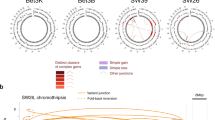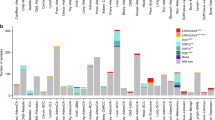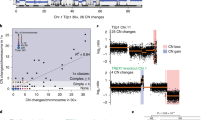Abstract
Progression to advanced-stage cervical carcinomas is characterized by a recurrent pattern of chromosomal rearrangements. Structural chromosome rearrangements are generated through the fusion of broken chromosome ends. These chromosome breaks may be induced by mutagenic agents such as ionizing radiation, or chromosome ends may be exposed through extensive telomere shortening. The human papilloma virus oncogene 16E6 induces telomerase activity in human keratinocytes, a model system for cervical tumor formation. The present study explores the relationship between 16E6 expression, telomerase activity, and chromosomal instability. We show that the frequency of anaphase bridges is dependent on the level of telomerase activity in 16E6/E7-expressing clones, and is the result of telomere shortening. High frequencies of anaphase bridges, associated with low telomerase activity, correlate with increased chromosome instability. Anaphase bridge formation is also associated with the presence of micronuclei, which are shown to contain unstable chromosomes frequently involved in rearrangements. As anaphase bridges are observed in both high and low telomerase 16E6/E7 clones, but not in hTERT-expressing control clones, expression of 16E6 in these immortalized clones is not sufficient to stabilize shortened telomeres completely. We suggest a model in which HPV-induced tumorigenesis may be dependent on persistent bridge–breakage–fusion cycles that allow for continued genomic rearrangements.
This is a preview of subscription content, access via your institution
Access options
Subscribe to this journal
Receive 50 print issues and online access
$259.00 per year
only $5.18 per issue
Buy this article
- Purchase on Springer Link
- Instant access to full article PDF
Prices may be subject to local taxes which are calculated during checkout









Similar content being viewed by others
References
Artandi SE, Chang S, Lee SL, Alson S, Gottlieb GJ, Chin L and DePinho RA . (2000). Nature, 406, 641–645.
Baege AC, Berger A, Schlegel R, Veldman T and Schlegel R . (2002). Am. J. Pathol., 160, 1251–1257.
Chang SC, Khoo C and DePinho RA . (2001). Sem. Cancer Biol., 11, 227–238.
Demers GW, Espling E, Harry JB, Etscheid BG and Galloway D . (1996). J. Virol., 70, 6862–6869.
Duensing S and Münger K . (2002). Cancer Res., 62, 7075–7082.
Duensing S, Lee LY, Duensing A, Basile J, Piboonniyom S, Gonzalez S, Crum CP and Münger K . (2000). Proc. Natl. Acad. Sci. USA, 97, 10002–10007.
Dyson N, Howley PM, Münger K and Harlow E . (1989). Science, 243, 934–937.
Filatov L, Golubovskaya V, Hurt JC, Byrd LL, Phillips JM and Kaufmann WK . (1998). Oncogene, 16, 1825–1838.
Ford JH, Schultz CJ and Correll AT . (1988). Am. J. Hum. Genet., 43, 733–740.
Gisselsson D, Bjork J, Hoglund M, Mertens F, Dal Cin P, Akerman M and Mandahl N . (2001a). Am. J. Pathol., 158, 199–206.
Gisselsson D, Jonson T, Petersen A, Strombeck B, Dal Cin P, Hoglund M, Mitelman F, Mertens F and Mandahl N . (2001b). Proc. Natl. Acad. Sci. USA, 98, 12683–12688.
Gisselsson D, Pettersson L, Hoglund M, Heidenblad M, Gorunova L, Wiegant J, Mertens F, Dal Cin P, Mitelman F and Mandahl N . (2000). Proc. Natl. Acad. Sci. USA, 97, 5357–5362.
Hawley-Nelson P, Vousden KH, Hubbert NL, Lowy DR and Schiller JT . (1989). EMBO J., 8, 3905–3910.
Helt AM, Funk JO and Galloway DA . (2002). J. Virol., 76, 10559–10568.
Heselmeyer K, Macville M, Schrock E, Blegen H, Hellstrom A-C, Shah K, Auer G and Ried T . (1997). Genes Chromosomes Cancer, 19, 233–240.
Heselmeyer K, Schrock E, du Manoir S, Blegen H, Shah K, Steinbeck R, Auer G and Ried T . (1996). Proc. Natl. Acad. Sci. USA, 93, 479–484.
Jones DL, Alani RM and Münger K . (1997). Genes Dev., 11, 2101–2111.
Kirchhoff M, Rose H, Petersen BL, Maahr J, Gerdes T, Lundsteen C, Bryndorf T, Kryger-Baggesen N, Christensen L, Engelholm SA and Philip J . (1999). Genes Chromosomes Cancer, 24, 144–150.
Kiyono T, Foster SA, Koop JI, McDougall JK, Galloway DA and Klingelhutz AJ . (1998). Nature, 396, 84–88.
Klingelhutz AJ, Barber SA, Smith PP, Dyer K and McDougall JK . (1994). Mol. Cell. Biol., 14, 961–969.
Klingelhutz AJ, Foster SA and McDougall JK . (1996). Nature, 380, 79–82.
Lakin ND and Jackson SP . (1999). Oncogene, 18, 7644–7655.
Lundblad V . (2000). Mutat. Res., 451, 227–240.
Maser RS and DePinho RA . (2002). Science, 297, 565–569.
Matthews CP, Shera KA and McDougall JK . (2000). Proc. Soc. Exp. Biol. Med., 223, 316–321.
McClintock B . (1941). Genetics, 26, 234–282.
McEachern MJ, Krauskopf A and Blackburn EH . (2000). Annu. Rev. Genet., 34, 331–358.
Meyerson M, Counter CM, Eaton EN, Elissen LW, Steiner P, Caddle SD, Ziaaugra L, Beijersbergen RL, Davidoff MJ, Liu Q, Bacchetti S, Haber DA and Weinberg RA . (1997). Cell, 90, 785–795.
Münger K, Phelps WC, Bubb V, Howley PM and Schlegel R . (1989). J. Virol., 63, 4417–4421.
Nakamura TM, Morin GB, Chapman KB, Weinrich SL, Andrews WH, Lingner J, Harley CB and Cech TR . (1997). Science, 277, 955–959.
O'Sullivan JN, Bronner MP, Brentnall TA, Finley JC, Shen WT, Emerson S, Emond MJ, Gollahon KA, Moskovitz AH, Crispin DA, Potter JD and Rabinovitch PS . (2002). Nat. Genet., 32, 280–284.
Plug-deMaggio AW and McDougall JK . (2002). Oncogene, 21, 7507–7513.
Rudolph KL, Millard M, Bosenberg MW and DePinho RA . (2001). Nat. Genet., 28, 155–159.
Scheffner M, Werness BA, Huibregtse JM, Levine AJ and Howley PM . (1990). Cell, 63, 1129–1136.
Veldman T, Horikawa I, Barrett JC and Schlegel R . (2001). J. Virol., 75, 4467–4472.
Werness BA, Levine AJ and Howley PM . (1990). Science, 248, 76–79.
Zur Hausen H . (2002). Nat. Rev. Cancer, 2, 342–350.
Acknowledgements
We thank Drs J O'Sullivan and K Gollahon, and M Pearlman for assistance in performing telomere length FISH.
Author information
Authors and Affiliations
Corresponding author
Rights and permissions
About this article
Cite this article
Plug-DeMaggio, A., Sundsvold, T., Wurscher, M. et al. Telomere erosion and chromosomal instability in cells expressing the HPV oncogene 16E6. Oncogene 23, 3561–3571 (2004). https://doi.org/10.1038/sj.onc.1207388
Received:
Revised:
Accepted:
Published:
Issue Date:
DOI: https://doi.org/10.1038/sj.onc.1207388
Keywords
This article is cited by
-
Large-scale analysis of protein expression changes in human keratinocytes immortalized by human papilloma virus type 16 E6 and E7 oncogenes
Proteome Science (2009)
-
Localization of TEIF in the centrosome and its functional association with centrosome amplification in DNA damage, telomere dysfunction and human cancers
Oncogene (2009)
-
Microtubule breakage is not a major mechanism for resolving end-to-end chromosome fusions generated by telomere dysfunction during the early process of immortalization
Chromosoma (2007)
-
Genomic imbalances in 70 snap-frozen cervical squamous intraepithelial lesions: associations with lesion grade, state of the HPV16 E2 gene and clinical outcome
British Journal of Cancer (2004)



